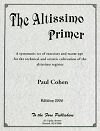 |
S367: The Altissimo Primer
by Paul Cohen. To the Fore
Publishers, 2014, SS, 45 pages. This book serves as an
introduction to the development of altissimo as a natural extension of
range. It provides an overview of the overtones and a set of fingerings
for the altissimo. Most of the books is devoted to a series of
exercises focusing on Scales and Arpeggios, The Equality of Registers,
and Cultivating an Artistic Facility. This book now says "Edition 2014"
on the cover but I can't tell what may have changed. |
14.95

|
 |
S854: Altissimo Studies for
Alto Saxophone
by Todd Rewoldt. Radnofsky Couper Editions, 2010, SS, 34 pages. The
focus of these studies is not to teach the basics of performing in the
altissimo, but to provide practical fingering patterns that will
increase speed and fluency. However, many studies often provide
numerous pages of scales and patterns that ask little more than to
“play up an octave.” Saxophonists, then, are required to choose from an
array of possible fingerings, often resulting in an inconsistent or
“clumsy” altissimo technique. To complement those study books that
provide fingerings, vocal/throat exercises, and patterns, Altissimo
Studies provides precise fingerings for each pitch of the included
altissimo scales, arpeggios, trills, and passages from the repertoire.
These fingering patterns are designed specifically to increase speed
and fluency in altissimo performance of the alto saxophone.
|
21.95

|
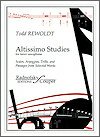 |
 S1190: Altissimo Studies for
Tenor Saxophone by Todd Rewoldt. Radnofsky Couper Editions,
2015, SS, 52 pages. The
author wrote: Tenor saxophone altissimo is widely used and accepted,
especially in the performance of jazz and rock music. While tenor
altissimo fingering charts and diagrams abound on the internet and in
several manuscripts, there is not as clear a teaching methodology for
tenor saxophone altissimo as there is for the alto; as I found during
my research for this book, altissimo on the tenor saxophone is a
completely different animal! As much as I had hoped to transfer alto
saxophone altissimo fingering patterns to tenor, issues such as
intonation, timbre, response, and fluid fingering patterns created many
difficulties. In particular, the fingering options for altissimo G#,
A#, and B made for extremely difficult and creative choices, ultimately
resolving with the decision that context (tempo, instrumentation,
dynamic, articulation, and style) is the most important aspect to
consider when deciding which fingering patterns to employ… that, and a
firm reed! To complement those study books and resources that provide
altissimo fingerings, vocal/throat exercises, and patterns, Altissimo
Studies provides precise fingerings for each pitch of the included
altissimo scales, arpeggios, trills, and passages from the repertoire.
These fingering patterns are designed specifically to increase speed
and fluency in altissimo performance of the tenor saxophone. The
fingerings included are by no means the only fingerings one could use
to practice in the altissimo register. My suggestions allow for the
saxophonist to incorporate fingerings that they are already comfortable
with (i.e. palm keys) and utilize the natural overtones that are
produced. Certainly, a method book such as Altissimo Studies will
promote greater fluidity and encourage others to standardize their own
altissimo fingerings. I hope that all saxophonists enjoy this book as
much as I have with its creation. S1190: Altissimo Studies for
Tenor Saxophone by Todd Rewoldt. Radnofsky Couper Editions,
2015, SS, 52 pages. The
author wrote: Tenor saxophone altissimo is widely used and accepted,
especially in the performance of jazz and rock music. While tenor
altissimo fingering charts and diagrams abound on the internet and in
several manuscripts, there is not as clear a teaching methodology for
tenor saxophone altissimo as there is for the alto; as I found during
my research for this book, altissimo on the tenor saxophone is a
completely different animal! As much as I had hoped to transfer alto
saxophone altissimo fingering patterns to tenor, issues such as
intonation, timbre, response, and fluid fingering patterns created many
difficulties. In particular, the fingering options for altissimo G#,
A#, and B made for extremely difficult and creative choices, ultimately
resolving with the decision that context (tempo, instrumentation,
dynamic, articulation, and style) is the most important aspect to
consider when deciding which fingering patterns to employ… that, and a
firm reed! To complement those study books and resources that provide
altissimo fingerings, vocal/throat exercises, and patterns, Altissimo
Studies provides precise fingerings for each pitch of the included
altissimo scales, arpeggios, trills, and passages from the repertoire.
These fingering patterns are designed specifically to increase speed
and fluency in altissimo performance of the tenor saxophone. The
fingerings included are by no means the only fingerings one could use
to practice in the altissimo register. My suggestions allow for the
saxophonist to incorporate fingerings that they are already comfortable
with (i.e. palm keys) and utilize the natural overtones that are
produced. Certainly, a method book such as Altissimo Studies will
promote greater fluidity and encourage others to standardize their own
altissimo fingerings. I hope that all saxophonists enjoy this book as
much as I have with its creation.
|
21.95

|
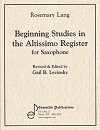 |
S571: Beginning Studies in
the
Altissimo Register for Saxophone by
Rosemary Lang revised and edited by Gail B. Levinsky. Ensemble
Publications, 2009, SS, 44 pages. This popular book (originally
published in 1971) is now back in
print in a new edition. Rosemary R. Lang (1920-1985) was a faculty
member at Butler University from 1948 until her death. Gail B. Levinsky
is on the faculty at Susquehanna University and was a music student at
Butler during the 1970s. This book begins with fundamental techniques
for
producing altissimo register tones, it provides fingerings for the alto
and tenor saxophone with numerous exercises and studies.
|
15.95

|
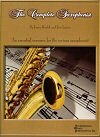 |
S369: The Complete
Saxophonist
by James Houlik and Eric Lauver. Northeastern Music Publications, 2007,
SS, 44 pages pages + CD. Subtitled: An Essential resource for the
serious saxophonists. While this book calls itself a method book it is
very similar to some of the books we have catgorized as Master Classes.
It focuses on aspects of saxophone playing such as tone development,
technical exercises (including alternate fingerings), articulation, and
vibrato. It also includes lyrical and technical etudes and a CD with
recordings of some the exercises from the book and
some artistic performances by Houlik and Donald Sinta.
|
23.95

|
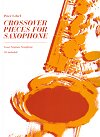 |

 / /
 S833:
Crossover Pieces for Saxophone by Peter Lehel. Advance
Music, 2011, PB, 123 pages + CD. This book offers performers on B-flat
saxophones (tenor or soprano) a wide variety of stylistically diverse
solo pieces in popular styles -- hip hop, boogaloo, Latin jazz, funk,
jazz ballad, shuffle blues, bossa nova, bolero, jazz waltz -- along
with comprehensive information about structure, melody, harmony, and
improvisation. These are the authors own compositions, many of which we
have for sale. The text is provided in English and German, and creative
exercises are also provided with each piece to strengthen performance
skills. The CD recording provides both demonstration and
play-along-with-rhythm-section tracks. The author rates the difficulty
level at medium to medium-advanced. (As this is primarily an
instructional book on jazz and pop genres, we have no idea why it has
this title.) Click
of the cover image to view the table of contents and sample pages. S833:
Crossover Pieces for Saxophone by Peter Lehel. Advance
Music, 2011, PB, 123 pages + CD. This book offers performers on B-flat
saxophones (tenor or soprano) a wide variety of stylistically diverse
solo pieces in popular styles -- hip hop, boogaloo, Latin jazz, funk,
jazz ballad, shuffle blues, bossa nova, bolero, jazz waltz -- along
with comprehensive information about structure, melody, harmony, and
improvisation. These are the authors own compositions, many of which we
have for sale. The text is provided in English and German, and creative
exercises are also provided with each piece to strengthen performance
skills. The CD recording provides both demonstration and
play-along-with-rhythm-section tracks. The author rates the difficulty
level at medium to medium-advanced. (As this is primarily an
instructional book on jazz and pop genres, we have no idea why it has
this title.) Click
of the cover image to view the table of contents and sample pages.
|
29.95

|
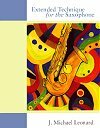 |
    S107:
Extended Technique for the Saxophone
by
J. Michael Leonard. Black Lion Press, 2004, SB, 61 pages. A
new edition of this book originally published in 1984. It covers basic
fundaments (fingering and alternates, trills, intonation, and pitch
alteration), harmonic studies, the altissimo register and fingering,
quarter tones and fingering, multiphonics and timbre alterations. With
the exception of the altissimo fingers which are quite detailed, this
book should be regarded as a reasonably priced introduction to extended
technique. S107:
Extended Technique for the Saxophone
by
J. Michael Leonard. Black Lion Press, 2004, SB, 61 pages. A
new edition of this book originally published in 1984. It covers basic
fundaments (fingering and alternates, trills, intonation, and pitch
alteration), harmonic studies, the altissimo register and fingering,
quarter tones and fingering, multiphonics and timbre alterations. With
the exception of the altissimo fingers which are quite detailed, this
book should be regarded as a reasonably priced introduction to extended
technique.
|
19.95

|
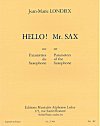 |
    S030:
Hello! Mr. Sax by Jean-Marie Londeix.
Alphonse Leduc,
1989, PB, 113 pages. Subtitled: Parameters of the Saxophone.
Text
is in French and English. Much of this book is devoted to extended
techniques
such as multiphonics, microtones, and special techniques of
timbre
and articulation. However, there sections on vibrato and other
techniques
that will be of interest to nearly all. Bass through sopranino are
covered. S030:
Hello! Mr. Sax by Jean-Marie Londeix.
Alphonse Leduc,
1989, PB, 113 pages. Subtitled: Parameters of the Saxophone.
Text
is in French and English. Much of this book is devoted to extended
techniques
such as multiphonics, microtones, and special techniques of
timbre
and articulation. However, there sections on vibrato and other
techniques
that will be of interest to nearly all. Bass through sopranino are
covered. |
57.80

|
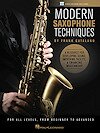 |
 S1208: Modern Saxophone Techniques
by Frank Catalano. Hal Leonard, 2016, PB, 101 pages with online audio
access. Many books present facts, but Modern Saxophone Techniques
teaches the developing player how to learn. The concepts presented will
keep players learning, maturing, and mastering the saxophone. In the
online video, author and virtuoso saxophonist Frank Catalano offers
quick tips on many of the topics covered in the book. “In the Band”
allows saxophonists to play along on six tunes and studies. Topics
include: developing good rhythm; air stream and embouchure; intervals,
melodies and bass lines; fingering charts; tonguing techniques; modern
harmony tips; split-tones and sub-tones; and an extensive set of
exercises in a variety of keys. Here
are more details from the publisher's website. S1208: Modern Saxophone Techniques
by Frank Catalano. Hal Leonard, 2016, PB, 101 pages with online audio
access. Many books present facts, but Modern Saxophone Techniques
teaches the developing player how to learn. The concepts presented will
keep players learning, maturing, and mastering the saxophone. In the
online video, author and virtuoso saxophonist Frank Catalano offers
quick tips on many of the topics covered in the book. “In the Band”
allows saxophonists to play along on six tunes and studies. Topics
include: developing good rhythm; air stream and embouchure; intervals,
melodies and bass lines; fingering charts; tonguing techniques; modern
harmony tips; split-tones and sub-tones; and an extensive set of
exercises in a variety of keys. Here
are more details from the publisher's website.
|
24.95

|
 |
S547: Multiphonics for the Saxophone
by John Gross. Advance Music, 1998, PB, 99 pages. Saxophonist John
Gross has been collecting multiphonics since 1961. This book with 178
different multiphonic fingerings is the result. They are grouped in
chapters giving 3 notes, 2 notes, and 4 or more notes. |
25.95

|
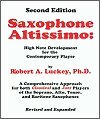 |
    S121:
Saxophone
Altissimo: High Note Development for the Contemporary Player
by Robert A. Luckey. Olympia Music Publishing, 1998 (Second Edition),
SB, 207 pages. This book features over 300 high note fingerings for the
soprano, alto, tenor, and baritone saxophones. It includes excerpts
from selected classical alto saxophone solos with recommended
fingerings for altissimo tones, as well as overtone exercises and
extended range exercises. There are also challenging jazz etudes
incorporating the altissimo register that can be performed with Jamey
Aebersold's Play-Along, Volume 43, Groovin'
High. S121:
Saxophone
Altissimo: High Note Development for the Contemporary Player
by Robert A. Luckey. Olympia Music Publishing, 1998 (Second Edition),
SB, 207 pages. This book features over 300 high note fingerings for the
soprano, alto, tenor, and baritone saxophones. It includes excerpts
from selected classical alto saxophone solos with recommended
fingerings for altissimo tones, as well as overtone exercises and
extended range exercises. There are also challenging jazz etudes
incorporating the altissimo register that can be performed with Jamey
Aebersold's Play-Along, Volume 43, Groovin'
High.
|
29.95

|
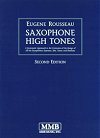 |
    S019:
Saxophone High Tones by Eugene Rousseau.
MMB Music
Inc., 1978, 2002, SS, 81 pages, second edition. The ability to exhibit
fluency in playing above the saxophone's normal range is no longer a
frill
or an option, it is a necessity. This book provides the tool to develop
and extended range on the soprano, alto, tenor and baritone saxophone.
It includes a fingering chart for the normal range and the high tones,
exercises that teach the techniques required for high tone production,
and exercises to practice these techniques. S019:
Saxophone High Tones by Eugene Rousseau.
MMB Music
Inc., 1978, 2002, SS, 81 pages, second edition. The ability to exhibit
fluency in playing above the saxophone's normal range is no longer a
frill
or an option, it is a necessity. This book provides the tool to develop
and extended range on the soprano, alto, tenor and baritone saxophone.
It includes a fingering chart for the normal range and the high tones,
exercises that teach the techniques required for high tone production,
and exercises to practice these techniques. |
29.95

|
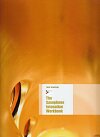 |
 S804:
The Saxophone Intonation Workbook by Trent Kynaston.
Advance Music, 2006, SS, 54 pages + CD. This book is a thorough,
organized approach to saxophone intonation. Basic concepts of
embouchure and breathing, understanding the role of your equipment, and
developing voicing techniques are all explored. Included are scale and
arpeggio studies along with a CD to practice tuning on the alto and
tenor saxophones. This is a must for all developing saxophonists. Click
on the cover image to view Table of Contents and what is on the
CD. S804:
The Saxophone Intonation Workbook by Trent Kynaston.
Advance Music, 2006, SS, 54 pages + CD. This book is a thorough,
organized approach to saxophone intonation. Basic concepts of
embouchure and breathing, understanding the role of your equipment, and
developing voicing techniques are all explored. Included are scale and
arpeggio studies along with a CD to practice tuning on the alto and
tenor saxophones. This is a must for all developing saxophonists. Click
on the cover image to view Table of Contents and what is on the
CD. |
26.95

|
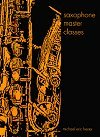 |
S013: Saxophone Master Classes by Michael Eric
Hester. Second
Edition, 2003, PB, 76 pages. Dr. Hester has written this series of
master
classes as a resource for students of the saxophone, university
instrumental
methods classes, and those teaching or intending to teach the
saxophone.
Principal subjects include embouchure, air (breathing), articulation,
vibrato,
altissimo, practicing, and saxophone diagnostic (squeak, thin sound,
bright
or uncontrolled sound, and poor response). |
15.95

|
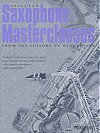 |
S059: Selected Saxophone Masterclasses from
the editors
of Windplayer. Windplayer Publications, 1998, SS, 31 pages. This book
contains
15 brief masterclasses on wide variety of subjects such as tone,
tonguing,
altissimo, soprano pitch problems and baritone sound by well known
saxophonists
such as Buddy Collette, Lew Tabackin, Jackie McLean, Jack Nimitz and
more. Click
on the cover image to view Table of Contents.
|
12.95

|
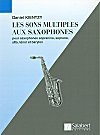 |
    S040:
Les Sons Multiples aux Saxophones by
Daniel Kientzy.
Salabert, 1982, PB, 80 pages. Multiphonic fingerings for the sopranino,
soprano, alto, tenor and baritone saxophones. French and English text. S040:
Les Sons Multiples aux Saxophones by
Daniel Kientzy.
Salabert, 1982, PB, 80 pages. Multiphonic fingerings for the sopranino,
soprano, alto, tenor and baritone saxophones. French and English text. |
41.95

|
 |
S705: Stratosphere:
Altissimo Etudes for Saxophone by
Noah Getz. Advance Music, 2011, SS, 47 pages. This book of altissimo
etudes is by Dr.
Noah Getz, a Washington DC based classical and jazz saxophonist and
music educator. In addition to the 20 etudes, this book also includes a
brief history of the altissimo register, considerations for developing
the altissimo register, and a one page listing of works that include
the altissimo register. |
24.95

|
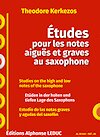 |

    S1175:
Studies on the High and Low Notes of the Saxophone by
Theodore Kerkezos. Alphonse Leduc, 2015, SS, 41 pages. This book
includes instrument specific altissimo fingerings. It has exercises for
high and low notes (including low A for the baritone). It also includes
a preface and notes in French, English, German and Spanish. S1175:
Studies on the High and Low Notes of the Saxophone by
Theodore Kerkezos. Alphonse Leduc, 2015, SS, 41 pages. This book
includes instrument specific altissimo fingerings. It has exercises for
high and low notes (including low A for the baritone). It also includes
a preface and notes in French, English, German and Spanish. |
22.95

|
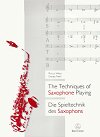 |
    S615:
The Techniques of Saxophone Playing by
Marcus Weiss and Giorgio Netti. Baerenreiter, 2010, PB, 110 pages. From
the publisher: " In
the last few years several publications have been devoted to advanced
playing techniques for wind instruments in contemporary music. Despite
this, players have continued to request a more comprehensive resource
with a better systematic approach, using practical examples from the
repertoire." This is the result from saxophonist Marcus Weiss and
composer Giorgio Netti. It covers microtones, altissimo, timbral
fingerings, multiphonics, articulations, sound and embouchure, and
other extended techniques. Musical examples of multiphonics and a
variety of performance techniques are provided through an internet link
The text is in German and English. "The book is an essential, practical
performing tool for interpreters,
teachers and composers." S615:
The Techniques of Saxophone Playing by
Marcus Weiss and Giorgio Netti. Baerenreiter, 2010, PB, 110 pages. From
the publisher: " In
the last few years several publications have been devoted to advanced
playing techniques for wind instruments in contemporary music. Despite
this, players have continued to request a more comprehensive resource
with a better systematic approach, using practical examples from the
repertoire." This is the result from saxophonist Marcus Weiss and
composer Giorgio Netti. It covers microtones, altissimo, timbral
fingerings, multiphonics, articulations, sound and embouchure, and
other extended techniques. Musical examples of multiphonics and a
variety of performance techniques are provided through an internet link
The text is in German and English. "The book is an essential, practical
performing tool for interpreters,
teachers and composers."
|
64.95

|
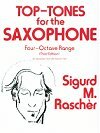 |
    S028.
Top-Tones for the Saxophone by Sigurd M.
Raschèr.
Carl Fischer, SS, 31 pages. Third Edition. This book is the key to
mastering
the extended upper range of the saxophone. It includes exercises to
develop
the technique necessary to produce the overtones necessary and
fingerings
for the tones above top F. Applicable to all saxophones. This
book
also includes the text in German. S028.
Top-Tones for the Saxophone by Sigurd M.
Raschèr.
Carl Fischer, SS, 31 pages. Third Edition. This book is the key to
mastering
the extended upper range of the saxophone. It includes exercises to
develop
the technique necessary to produce the overtones necessary and
fingerings
for the tones above top F. Applicable to all saxophones. This
book
also includes the text in German. |
12.95

|
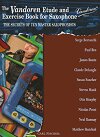 |
S729: The Vandoren Etude
and Exercise Book for the Saxophone. Carl Fischer, 2011, PB, 84
pages. Subtitled: The Secrets of Ten Master Saxophonists. The Vandoren
Company and Carl Fischer Music have teamed up with ten of the finest
saxophonists in the world to create a one-of-a-kind etude and exercise
book. Each of these saxophone masters share their inner secrets of
saxophone playing. This eclectic collection covers a wide range of
challenges to mastering the saxophone, containing etudes to develop
tone, technique, lyricism, and overall musicianship. No serious student
or teacher should be without the innovative wisdom of this collection,
which also includes warm-ups, altissimo fingerings and exercises, a
complete quarter-tone fingering chart as well as Arabic rhythmic and
melodic exercises. Featuring contributions from Serge Bertocchi, Paul
Bro, James Bunte, Claude Delangle, Susan Fancher, Steven Mauk, Otis
Murphy, Nicolas Prost, Neal Ramsay, and Matthew Sintchak.
|
24.95

|
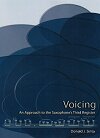 |
 S835: Voicing, an
Approach to
the Saxophone's Third Register by Donald Sinta. Meridian Winds,
SB, 85 pages. Proficiency in the altissimo register is a
necessity for the contemporary saxophonist. This book is a series of
exercises that are designed to yield insight, develop control over the
supporting physiology, reduce anxiety and failure, and allow and
serious student to master this frequently elusive range. This book is
the same as the previously available edition of this book with the
addition of 6 pages on Donald Sinta. S835: Voicing, an
Approach to
the Saxophone's Third Register by Donald Sinta. Meridian Winds,
SB, 85 pages. Proficiency in the altissimo register is a
necessity for the contemporary saxophonist. This book is a series of
exercises that are designed to yield insight, develop control over the
supporting physiology, reduce anxiety and failure, and allow and
serious student to master this frequently elusive range. This book is
the same as the previously available edition of this book with the
addition of 6 pages on Donald Sinta. |
24.95

|




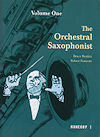
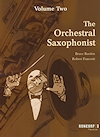



 S1190: Altissimo Studies for
Tenor Saxophone by Todd Rewoldt. Radnofsky Couper Editions,
2015, SS, 52 pages. The
author wrote: Tenor saxophone altissimo is widely used and accepted,
especially in the performance of jazz and rock music. While tenor
altissimo fingering charts and diagrams abound on the internet and in
several manuscripts, there is not as clear a teaching methodology for
tenor saxophone altissimo as there is for the alto; as I found during
my research for this book, altissimo on the tenor saxophone is a
completely different animal! As much as I had hoped to transfer alto
saxophone altissimo fingering patterns to tenor, issues such as
intonation, timbre, response, and fluid fingering patterns created many
difficulties. In particular, the fingering options for altissimo G#,
A#, and B made for extremely difficult and creative choices, ultimately
resolving with the decision that context (tempo, instrumentation,
dynamic, articulation, and style) is the most important aspect to
consider when deciding which fingering patterns to employ… that, and a
firm reed! To complement those study books and resources that provide
altissimo fingerings, vocal/throat exercises, and patterns, Altissimo
Studies provides precise fingerings for each pitch of the included
altissimo scales, arpeggios, trills, and passages from the repertoire.
These fingering patterns are designed specifically to increase speed
and fluency in altissimo performance of the tenor saxophone. The
fingerings included are by no means the only fingerings one could use
to practice in the altissimo register. My suggestions allow for the
saxophonist to incorporate fingerings that they are already comfortable
with (i.e. palm keys) and utilize the natural overtones that are
produced. Certainly, a method book such as Altissimo Studies will
promote greater fluidity and encourage others to standardize their own
altissimo fingerings. I hope that all saxophonists enjoy this book as
much as I have with its creation.
S1190: Altissimo Studies for
Tenor Saxophone by Todd Rewoldt. Radnofsky Couper Editions,
2015, SS, 52 pages. The
author wrote: Tenor saxophone altissimo is widely used and accepted,
especially in the performance of jazz and rock music. While tenor
altissimo fingering charts and diagrams abound on the internet and in
several manuscripts, there is not as clear a teaching methodology for
tenor saxophone altissimo as there is for the alto; as I found during
my research for this book, altissimo on the tenor saxophone is a
completely different animal! As much as I had hoped to transfer alto
saxophone altissimo fingering patterns to tenor, issues such as
intonation, timbre, response, and fluid fingering patterns created many
difficulties. In particular, the fingering options for altissimo G#,
A#, and B made for extremely difficult and creative choices, ultimately
resolving with the decision that context (tempo, instrumentation,
dynamic, articulation, and style) is the most important aspect to
consider when deciding which fingering patterns to employ… that, and a
firm reed! To complement those study books and resources that provide
altissimo fingerings, vocal/throat exercises, and patterns, Altissimo
Studies provides precise fingerings for each pitch of the included
altissimo scales, arpeggios, trills, and passages from the repertoire.
These fingering patterns are designed specifically to increase speed
and fluency in altissimo performance of the tenor saxophone. The
fingerings included are by no means the only fingerings one could use
to practice in the altissimo register. My suggestions allow for the
saxophonist to incorporate fingerings that they are already comfortable
with (i.e. palm keys) and utilize the natural overtones that are
produced. Certainly, a method book such as Altissimo Studies will
promote greater fluidity and encourage others to standardize their own
altissimo fingerings. I hope that all saxophonists enjoy this book as
much as I have with its creation. 









 S804:
The Saxophone Intonation Workbook by Trent Kynaston.
Advance Music, 2006, SS, 54 pages + CD. This book is a thorough,
organized approach to saxophone intonation. Basic concepts of
embouchure and breathing, understanding the role of your equipment, and
developing voicing techniques are all explored. Included are scale and
arpeggio studies along with a CD to practice tuning on the alto and
tenor saxophones. This is a must for all developing saxophonists. Click
on the cover image to view Table of Contents and what is on the
CD.
S804:
The Saxophone Intonation Workbook by Trent Kynaston.
Advance Music, 2006, SS, 54 pages + CD. This book is a thorough,
organized approach to saxophone intonation. Basic concepts of
embouchure and breathing, understanding the role of your equipment, and
developing voicing techniques are all explored. Included are scale and
arpeggio studies along with a CD to practice tuning on the alto and
tenor saxophones. This is a must for all developing saxophonists. Click
on the cover image to view Table of Contents and what is on the
CD. 







